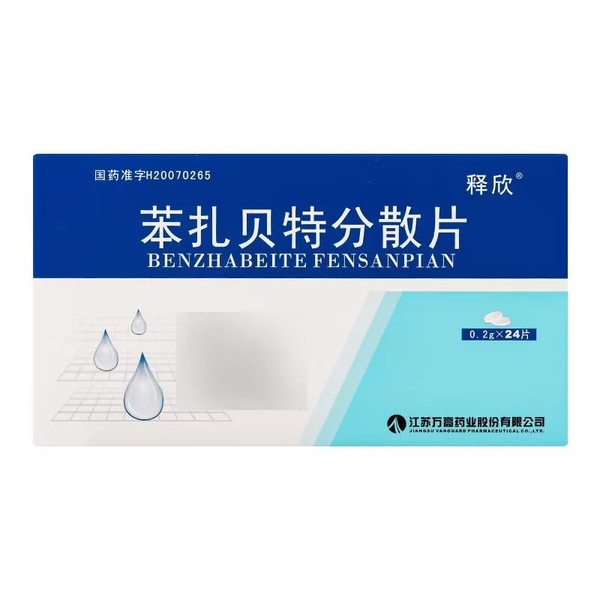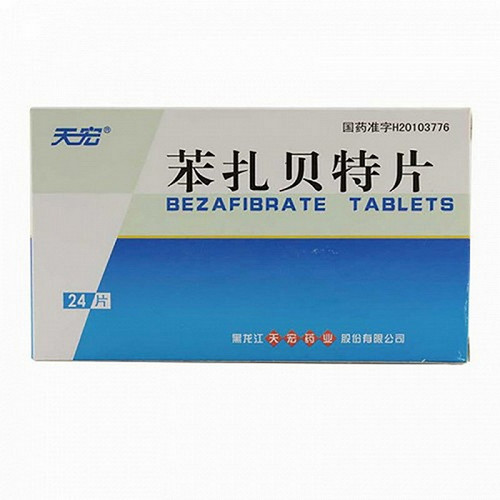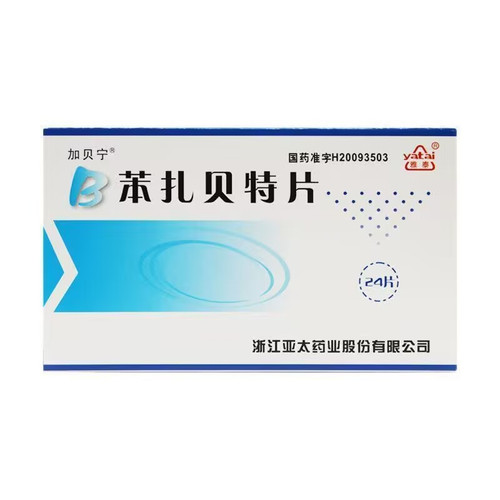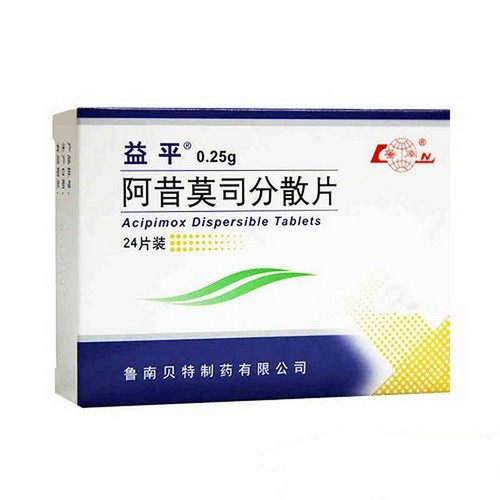Product Overview
[Drug Name]
Generic Name: Bezafibrate Dispersible Tablets
Trade Name: Shixin
English Name: Bezafibrate Dispersible Tablets
Chinese Pinyin: Benzhabeite Fensan Pian
[Ingredients]
[4-Chlorobenzoyl-β-aminoethylphenoxy]isobutyric acid
[Properties]
This product is a film-coated tablet. When the film coating is removed, it appears white or off-white.
[Indications]
For the treatment of hypertriglyceridemia, hypercholesterolemia, and combined hyperlipidemia.
[Dosage and Administration]
The usual adult dosage of Bezafibrate Dispersible Tablets is 0.2-0.4 g three times daily. It can be taken with or after meals. For patients with optimal efficacy, the maintenance dose can be 0.4 g twice daily. In cases of renal impairment, the dosage should be adjusted according to creatinine clearance: 40-60 ml/min, 0.4 g twice daily; 15-40 ml/min, 0.4 g once daily or every other day; below 15 ml/min.
[Adverse Reactions]
1. The most common adverse reactions are gastrointestinal discomfort, such as indigestion, anorexia, nausea, vomiting, fullness, and stomach discomfort. Other less common adverse reactions include headache, dizziness, fatigue, rash, itching, impotence, anemia, and decreased white blood cell count. 2. Occasionally, cholelithiasis or myositis (myalgia, fatigue) may occur. This product is a clofibric acid derivative and may cause myositis, myopathy, and rhabdomyolysis, leading to elevated blood creatine phosphokinase. Rhabdomyolysis, primarily manifested by myalgia combined with elevated blood creatine phosphokinase and myoglobinuria, may lead to renal failure, but this is rare. Patients with nephrotic syndrome or other renal impairment leading to hypoalbuminemia, or those with hyperthyroidism, are at increased risk of myopathy. 3. Rarely, elevated serum aminotransferases may occur.
[Contraindications]
Not yet established.
[Precautions]
1. This product may interfere with diagnosis. ① Decreased hemoglobin and white blood cell counts may occur. ② Increased serum aminotransferases may occur. ③ Increased serum creatinine may occur. 2. Regular monitoring during medication should include: ① Complete blood count and platelet count; ② Liver and kidney function tests; ③ Blood lipids; ④ Blood creatine phosphokinase. 3. If cholelithiasis, significant liver function abnormalities, suspected myopathy symptoms (such as myalgia, tenderness, fatigue), or a significant increase in blood creatine phosphokinase occur after medication, discontinue the drug. 4. While treating hyperlipidemia, it is also important to monitor and treat underlying conditions that may cause hyperlipidemia, such as hypothyroidism and diabetes. Certain medications, such as estrogens, thiazide diuretics, and beta-blockers, can also cause hyperlipidemia. After discontinuation of these medications, corresponding anti-hyperlipidemic treatment is no longer necessary.
[Use in Special Populations]
Precautions for Children:
The efficacy and safety of this product in children have not yet been confirmed by experimental studies, so it should not be used.
Precautions for Pregnancy and Lactation:
The safety of this product during pregnancy has not been established, so its use is not recommended for pregnant women. It is unknown whether this product is secreted into breast milk, so it should not be used by lactating women.
Precautions for the Elderly:
The elderly should adjust their medication dosage based on their liver and kidney function. If renal function is impaired, the dosage of this product should be appropriately reduced.
[Drug Interactions]
1. This product may significantly enhance the effects of oral anticoagulants. When used concomitantly with this product, the oral anticoagulant dose should be reduced and the prothrombin time should be monitored frequently to adjust the anticoagulant dose. Its mechanism of action is uncertain, but it may be due to its ability to displace warfarin and other drugs from their protein binding sites, thereby enhancing their effects. 2. When this drug is used in combination with other highly protein-bound drugs, it may displace them from protein binding sites, potentially enhancing their effects. Examples include tolbutamide and other sulfonylurea hypoglycemic drugs, phenytoin, and furosemide. If these drugs are taken during lipid-lowering therapy, the dosage of these hypoglycemic and other medications should be adjusted. 3. The combined use of clofibric acid derivatives with HMG-CoA reductase inhibitors, such as lovastatin, for the treatment of hyperlipidemia increases the risk of severe muscle toxicity from both agents, potentially causing myalgia, rhabdomyolysis, and elevated serum creatine phosphokinase. Therefore, combined use should be avoided. 4. This drug is primarily excreted via the kidneys. Combination use with immunosuppressants, such as cyclosporine, can increase their blood concentrations and nephrotoxicity, potentially worsening renal function. Therefore, the dose should be reduced or discontinued. Caution should also be exercised when this drug is used in combination with other nephrotoxic drugs. 5. This drug can enhance the effects of hypoglycemic drugs.
[Pharmacological Action]
This drug is a clofibric acid derivative, a lipid-regulating drug. Its lipid-lowering effects are driven by two mechanisms. First, it increases the activity of lipoprotein lipase and hepatic lipase, promoting the breakdown of very low-density lipoprotein (VLDL), thereby lowering blood triglyceride levels. Second, it reduces VLDL secretion. This drug lowers both LDL and cholesterol, possibly by enhancing the clearance of receptor-bound LDL. This drug's effect on lowering blood triglycerides is stronger than its effect on lowering cholesterol, and it also increases high-density lipoprotein (HDL). Furthermore, it can lower blood fibrinogen. Existing studies have not shown this drug to be carcinogenic or mutagenic.
[Storage] Store in a cool, dark, airtight container.
[Strength] 0.2g
[Packaging Size] 0.2g x 24 tablets/box
[Expiry Life] 24 months
[Approval Number] National Medicine Standard H20070265
[Manufacturer] Company Name: Jiangsu Wangao Pharmaceutical Co., Ltd.






